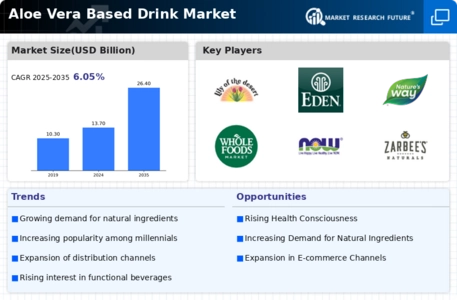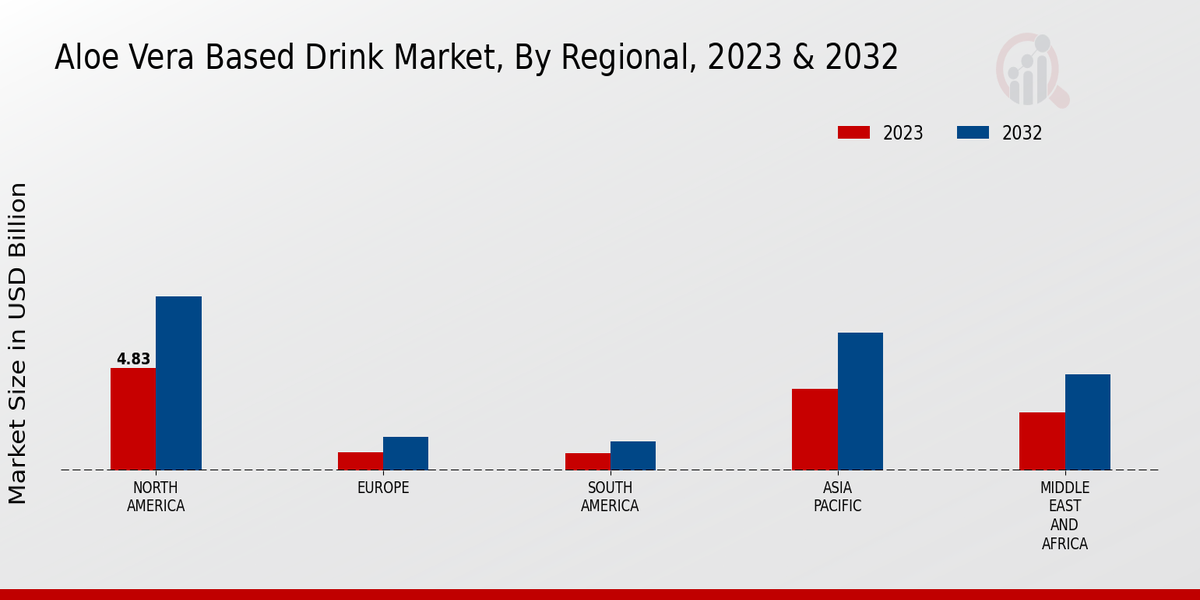Sustainability Trends
Sustainability trends are becoming increasingly relevant in the Global Aloe Vera Based Drink Market Industry. Consumers are more inclined to support brands that prioritize environmentally friendly practices, such as sustainable sourcing and eco-friendly packaging. This shift is prompting manufacturers to adopt greener production methods and transparency in their supply chains. As a result, brands that align with these values are likely to gain a competitive edge. The emphasis on sustainability not only appeals to environmentally conscious consumers but also contributes to the overall growth of the market, as it reflects a broader societal shift towards responsible consumption.
Market Growth Projections
The Global Aloe Vera Based Drink Market Industry is projected to experience substantial growth, with estimates indicating a rise from 13.7 USD Billion in 2024 to 26.4 USD Billion by 2035. This growth trajectory suggests a robust demand for aloe vera beverages, driven by various factors such as health consciousness, innovative product development, and sustainability trends. The anticipated compound annual growth rate (CAGR) of 6.12% from 2025 to 2035 further underscores the market's potential. These projections highlight the increasing consumer inclination towards natural and health-oriented products, positioning aloe vera drinks favorably in the evolving beverage landscape.
Rising Health Consciousness
The increasing awareness of health and wellness among consumers appears to drive the Global Aloe Vera Based Drink Market Industry. As individuals seek natural alternatives to sugary beverages, aloe vera drinks, known for their hydrating and digestive benefits, gain popularity. This trend is particularly evident in regions with a growing emphasis on preventive healthcare. The market is projected to reach 13.7 USD Billion in 2024, reflecting a shift towards healthier lifestyle choices. Consumers are increasingly inclined to choose products that offer functional benefits, suggesting that the demand for aloe vera-based drinks will continue to rise as health consciousness expands globally.
Innovative Product Development
Innovation in product development plays a crucial role in the Global Aloe Vera Based Drink Market Industry. Manufacturers are increasingly introducing new flavors, formulations, and packaging options to attract diverse consumer segments. For instance, the incorporation of functional ingredients such as vitamins and minerals enhances the appeal of aloe vera drinks. This trend aligns with the growing consumer preference for products that offer additional health benefits. As a result, the market is likely to witness a compound annual growth rate (CAGR) of 6.12% from 2025 to 2035, indicating a robust future for innovative aloe vera beverages that cater to evolving consumer tastes.
Expansion of Distribution Channels
The Global Aloe Vera Based Drink Market Industry benefits from the expansion of distribution channels, including online platforms and retail outlets. The rise of e-commerce has made aloe vera drinks more accessible to consumers, allowing for a broader reach. This trend is particularly significant in urban areas where convenience is paramount. Retailers are increasingly stocking these beverages, catering to the growing demand. As a result, the market is expected to experience substantial growth, potentially reaching 26.4 USD Billion by 2035. This expansion indicates a shift in consumer purchasing behavior, as more individuals opt for convenient and readily available health-oriented products.
Cultural Acceptance and Globalization
Cultural acceptance and globalization significantly influence the Global Aloe Vera Based Drink Market Industry. As aloe vera drinks gain popularity in various regions, they are increasingly integrated into local diets and lifestyles. This trend is particularly evident in regions where traditional herbal remedies are valued. The globalization of food and beverage trends facilitates the introduction of aloe vera drinks to new markets, enhancing their acceptance. This cultural integration suggests a promising future for the market, as it expands beyond traditional boundaries and taps into diverse consumer preferences worldwide.























